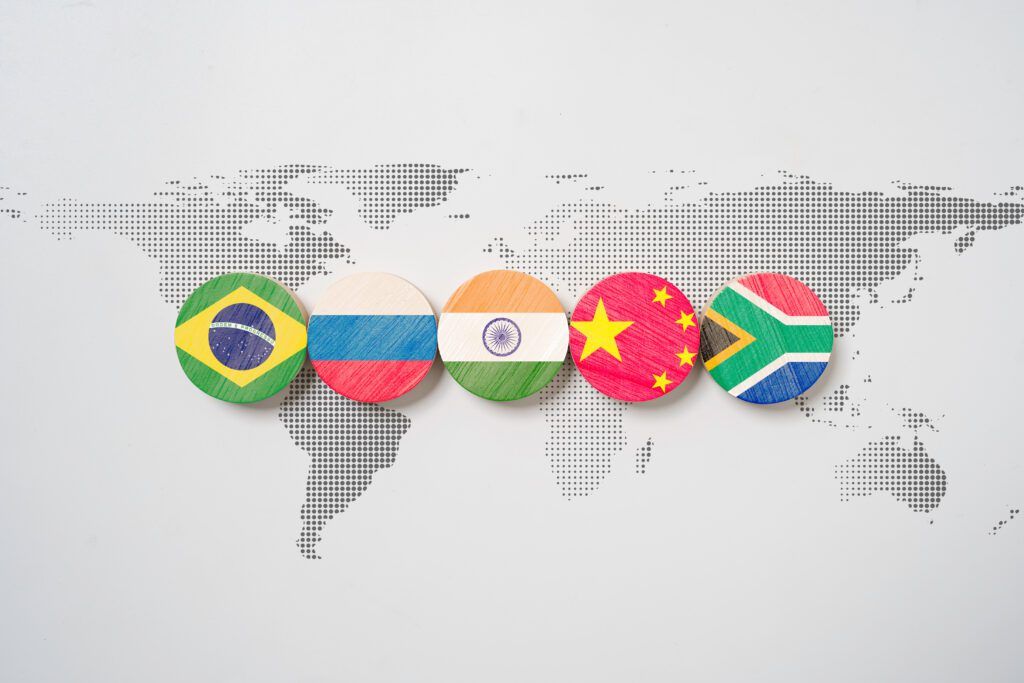BRICS, an acronym for Brazil, Russia, India, China, and South Africa, represents a dynamic alliance of emerging economies that has captured global attention since its inception in 2006. As a forum for cooperation and collaboration, BRICS plays a pivotal role in shaping international relations, economic development, and geopolitical dynamics. Let’s explore the origins, objectives, and impact of the BRICS organization on the global stage.
Exploring the Economic Impact of BRICS on Emerging Markets
Origins of BRICS:
The concept of BRICS emerged from informal discussions among the leaders of Brazil, Russia, India, and China at the margins of the UN General Assembly in 2006. These countries recognized their shared interests and common challenges and sought to establish a platform for dialogue and cooperation. South Africa joined the alliance in 2010, expanding its geographical and geopolitical scope.

Objectives of BRICS:
BRICS aims to promote mutual cooperation, dialogue, and partnership among its member states across various domains, including economics, politics, and culture. The organization seeks to advance common interests, address shared challenges, and enhance the voice and representation of emerging economies in global governance structures. Key objectives of BRICS include:
- Economic Cooperation: BRICS promotes trade, investment, and economic cooperation among its member states, with a focus on enhancing growth, development, and prosperity. Initiatives such as the New Development Bank (NDB) and the Contingent Reserve Arrangement (CRA) facilitate financial cooperation and infrastructure development within the BRICS countries and beyond.
- Political Dialogue: BRICS serves as a forum for political dialogue and strategic cooperation on regional and global issues of mutual interest. Member states engage in regular summits, ministerial meetings, and working groups to discuss pressing geopolitical challenges, such as climate change, terrorism, and global governance reform.
- Cultural Exchange: BRICS promotes cultural exchange, people-to-people ties, and academic collaboration among its member states. Cultural festivals, academic conferences, and youth exchanges foster greater understanding, appreciation, and cooperation among the diverse cultures and civilizations represented linetogel within the BRICS alliance.
Impact of BRICS:
Since its establishment, BRICS has emerged as a significant force in shaping global economic and geopolitical dynamics. The organization has facilitated increased cooperation and coordination among its member states, leading to tangible outcomes in various areas:
- Economic Growth: BRICS countries collectively account for a substantial share of global GDP, trade, and foreign direct investment. Enhanced economic cooperation within BRICS has contributed to sustained growth, job creation, and poverty reduction in member states and has bolstered their resilience to external economic shocks.
- Multilateralism: BRICS promotes a multipolar world order based on the principles of multilateralism, inclusivity, and respect for sovereignty and territorial integrity. The organization advocates for reform of global governance institutions, such as the United Nations, International Monetary Fund, and World Bank, to better reflect the realities of the 21st century.
- South-South Cooperation: BRICS fosters South-South cooperation and solidarity among developing countries, offering an alternative model of development cooperation that prioritizes mutual benefit, equality, and non-interference. The NDB and CRA exemplify BRICS’ commitment to promoting sustainable development and infrastructure financing in emerging economies.
Conclusion:
BRICS stands as a testament to the growing influence and relevance of emerging economies in shaping the future of the global order. As a forum for cooperation and collaboration, BRICS continues to champion economic growth, political dialogue, and cultural exchange among its member states and beyond. Despite challenges and divergent interests, BRICS remains committed to advancing common goals and addressing shared challenges in pursuit of a more just, equitable, and multipolar world.
The Formation Strategy of BRICS: Fostering Collaboration Among Emerging Powers

The establishment of the BRICS alliance marked a significant milestone in the evolution of global governance and cooperation among emerging economies. Born out of a shared vision for mutual development and cooperation, BRICS emerged as a formidable force on the world stage. This article explores the strategic underpinnings behind the formation of BRICS and how it has evolved into a dynamic platform for collaboration and influence.
Identifying Common Interests:
The formation of BRICS was rooted in the recognition of shared interests and aspirations among its founding members: Brazil, Russia, India, China, and later joined by South Africa. These countries, despite their diverse histories, cultures, and political systems, identified common challenges and opportunities in the global landscape, including economic development, poverty alleviation, and geopolitical rebalancing.
Economic Rationale:
Economic considerations played a pivotal role in the formation of BRICS. The member states recognized the growing importance of emerging economies in driving global growth and sought to leverage their collective economic clout for mutual benefit. With their combined GDP accounting for a significant share of global output, BRICS countries aimed to strengthen economic cooperation, promote trade and investment, and enhance their bargaining power in international forums.
Geopolitical Dynamics:
The geopolitical landscape of the early 21st century witnessed a shift in power dynamics, with emerging economies asserting themselves on the world stage. BRICS emerged as a counterbalance to the dominance of Western powers in global governance institutions and sought to amplify the voices and interests of developing countries. By forging a united front, BRICS aimed to challenge existing norms and institutions perceived as skewed in favor of developed nations.
Strategic Partnerships:
In addition to its internal cohesion, BRICS strategically cultivated partnerships with other emerging economies, regional blocs, and international organizations. Through outreach initiatives such as the BRICS Plus framework, BRICS engaged with countries across continents, fostering dialogue, cooperation, and mutual understanding. These strategic partnerships expanded the influence and relevance of BRICS on the global stage and facilitated the exchange of best practices and expertise.
Institutional Framework:
To operationalize its objectives, BRICS established institutional mechanisms, including annual summits, ministerial meetings, and working groups focused on key areas of cooperation such as finance, trade, and security. The creation of the New Development Bank (NDB) and the Contingent Reserve Arrangement (CRA) provided tangible platforms for financial cooperation and infrastructure development among BRICS countries.
Conclusion:
The formation of BRICS was guided by a strategic vision to harness the collective strength of emerging economies for mutual benefit and global influence. By identifying common interests, leveraging economic rationale.
Assessing the Pros and Cons of BRICS: Strengths and Weaknesses of the Alliance

Since its inception, BRICS has emerged as a significant player in global politics and economics, representing a coalition of five major emerging economies: Brazil, Russia, India, China, and South Africa. While the alliance has garnered attention for its potential to reshape international relations, it is essential to examine both its strengths and weaknesses to gain a comprehensive understanding of its impact.
Pros of BRICS:
- Economic Powerhouse: One of the primary strengths of BRICS lies in its economic clout. Collectively, the member states represent a substantial share of global GDP, trade, and foreign direct investment, giving them considerable influence in shaping the global economic landscape.
- Diversification of Trade and Investment: BRICS facilitates diversification of trade and investment opportunities among its member states, reducing their dependence on traditional Western markets. This diversification strengthens their resilience to external economic shocks and enhances their bargaining power in international trade negotiations.
- Financial Cooperation: The establishment of institutions like the New Development Bank (NDB) and the Contingent Reserve Arrangement (CRA) demonstrates BRICS’ commitment to financial cooperation and infrastructure development. These institutions provide alternative sources of financing for development projects, particularly in emerging markets.
- Geopolitical Balance: BRICS serves as a counterbalance to the dominance of Western powers in global governance institutions. By advocating for a multipolar world order, BRICS seeks to promote inclusivity, equality, and respect for sovereignty in international relations.
Cons of BRICS:
- Divergent Interests: Despite their shared objectives, BRICS member states have divergent interests and priorities, stemming from differences in political systems, economic structures, and strategic goals. This diversity of interests can complicate decision-making and consensus-building within the alliance.
- Institutional Challenges: BRICS faces institutional challenges, including bureaucratic inefficiencies and coordination issues, which hinder the implementation of its initiatives and agreements. Strengthening institutional mechanisms and enhancing cooperation among member states are essential for overcoming these challenges.
- Economic Disparities: Economic disparities among BRICS member states pose a challenge to the alliance’s cohesion and solidarity. While countries like China and India are rapidly growing economies, others such as Brazil and South Africa face economic challenges and structural constraints that limit their growth potential.
- Limited Influence: Despite its economic and geopolitical significance, BRICS’ influence on global affairs remains limited compared to established powers like the United States and the European Union. Overcoming this limitation requires greater coordination, strategic alignment, and collective action among member states.
Conclusion:
BRICS represents a unique experiment in international cooperation among emerging economies, offering both opportunities and challenges. While the alliance has made significant strides in promoting economic cooperation, financial integration, and geopolitical rebalancing, it also faces hurdles related to divergent interests, institutional constraints, and limited influence. Addressing these challenges requires sustained commitment, dialogue, and cooperation among BRICS member states, as they strive to realize their vision of a more just, equitable, and multipolar world order.